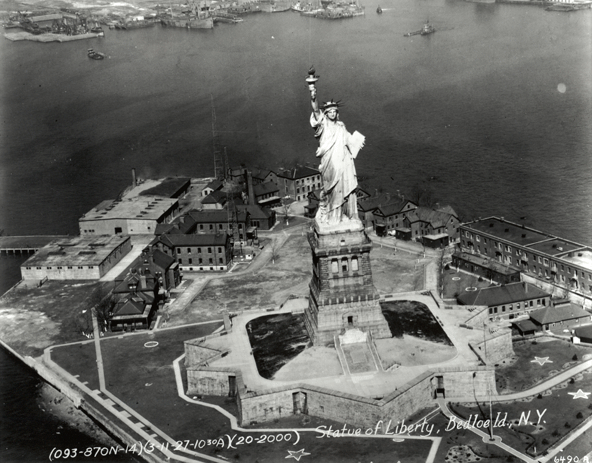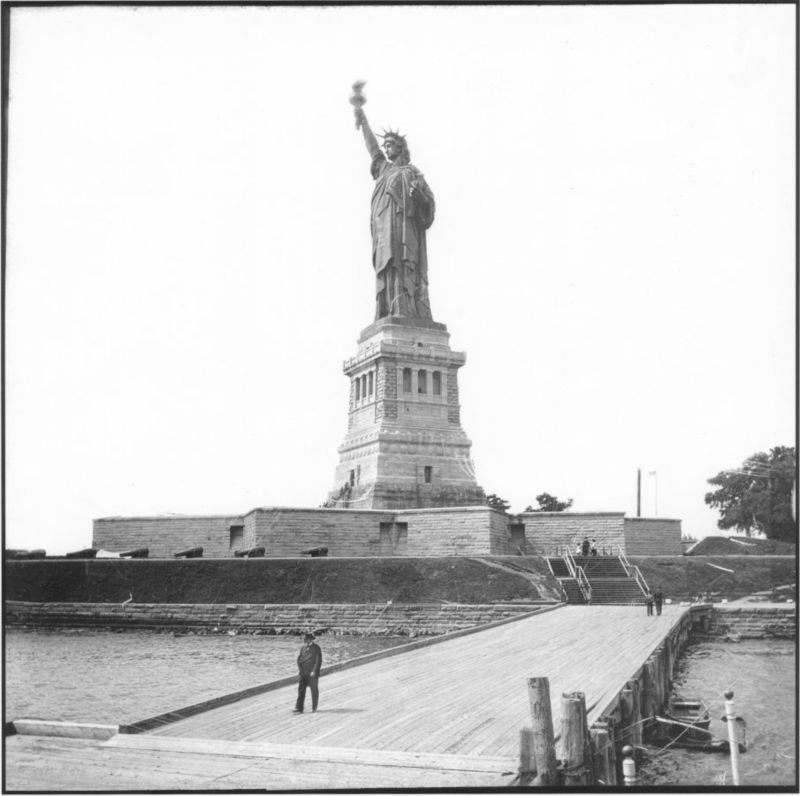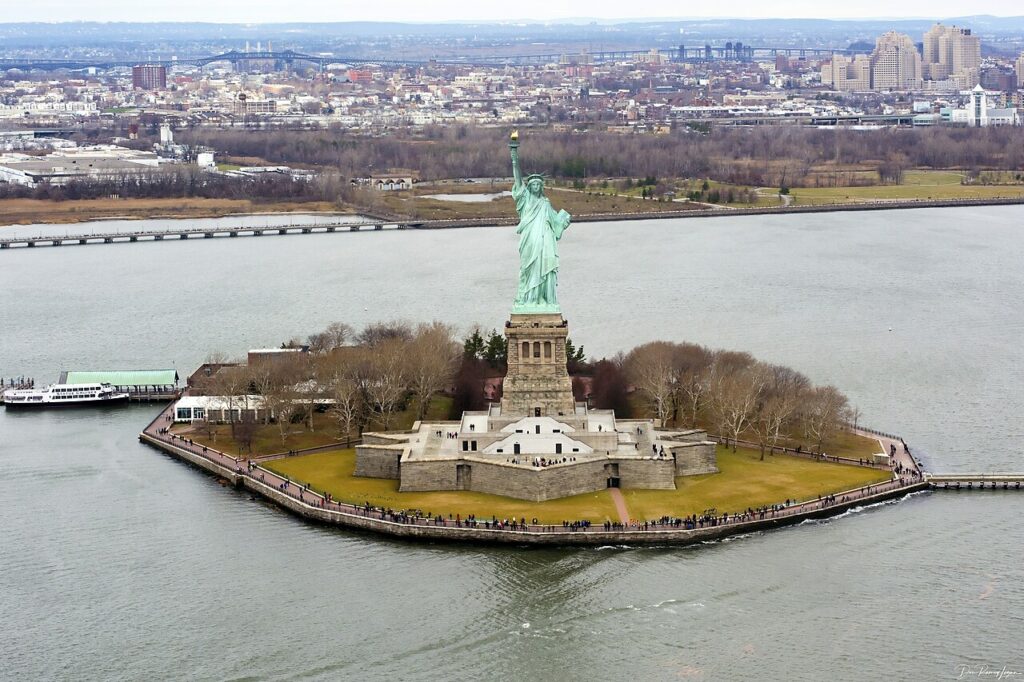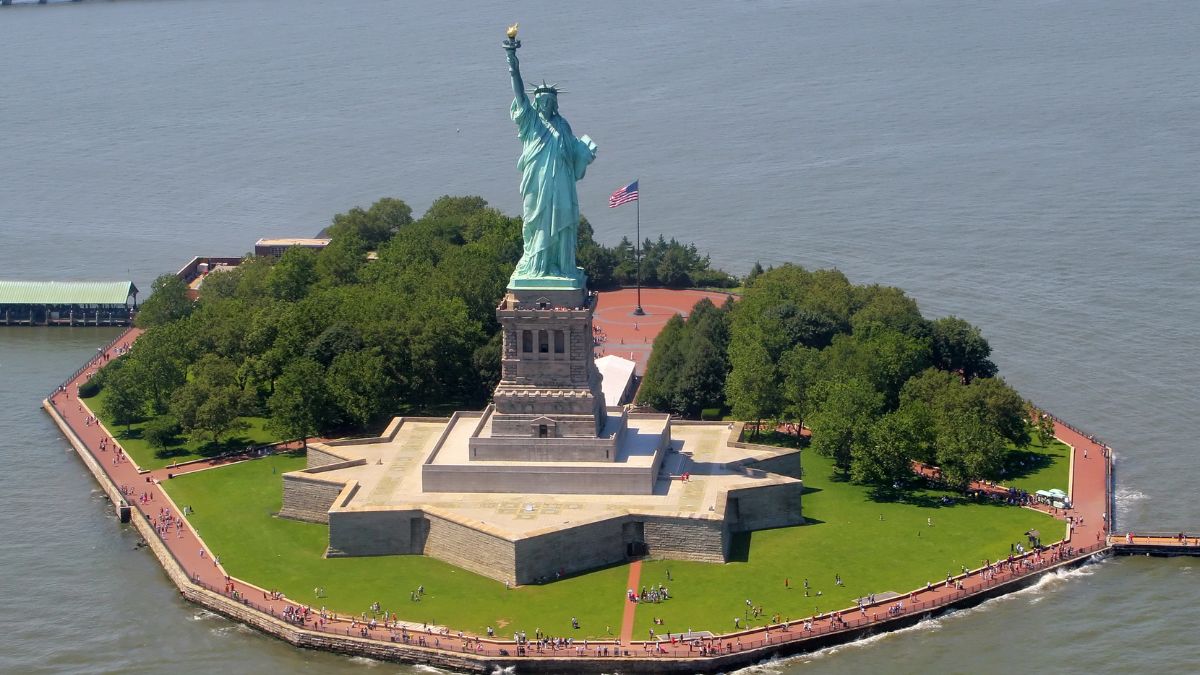Strategically located within the pulsing heart of New York Harbor, shadowed by the majestic Statue of Liberty, Fort Wood emerges—a silent guardian of America’s past military endeavors and a beacon of the nation’s enduring values.
Erected on what we now know as Liberty Island, this historic bastion captures the essence of America’s defense strategies and their metamorphosis into a powerful message of freedom and welcome that resonates globally.
Join us on a journey through the hallowed grounds of Fort Wood, where every stone and cannon whispers tales of bravery and transformation.
Foundations of Fort Wood

Fort Wood, an integral part of the United States’ defensive strategy, was erected between 1807 and 1811. This was in response to the mounting tensions and potential conflicts that loomed over New York City.
This fortification was vital to the Second System of US fortifications, which followed the War of 1812.
Designed in a distinctive star shape, Fort Wood’s polygonal architecture was visually striking and strategically advantageous.
The layout allowed for a broad and devastating range of fire. Enabling the fort to unleash a formidable defense against any maritime aggressions that threatened the port of NYC.
The star-shaped design also provided a robust structural resistance, making it a formidable obstacle for enemy ships considering an approach.
The geopolitical climate evolved as time progressed, and the likelihood of coastal attacks on New York City diminished. The fort’s role as a military stronghold became less vital.
During this period of transformation, Fort Wood transitioned from a military installation to a platform for a new symbol of freedom and democracy.
Fort Wood Became the Foundation for the Statue of Liberty
In 1886, Fort Wood found its enduring purpose when it became the foundation for the Statue of Liberty.
The statue, a gift from France designed by Frédéric Auguste Bartholdi and engineered by Gustave Eiffel, was a monumental token of friendship between the two nations and a universal symbol of liberty.
Fort Wood’s star-shaped base was repurposed to support the pedestal of this iconic statue. This has since become one of the United States’ most revered landmarks and a beacon of hope for millions worldwide.
The Evolution of Fort Wood

The Gift of Liberty
In the waning years of the 19th century, Fort Wood’s strategic military relevance began to wane. This period of change set the stage for the fort to become a symbolic site of freedom.
In 1886, Fort Wood’s transformation was solidified through the unveiling of the Statue of Liberty, a gift from the people of France to the United States.
This gift celebrated the centennial of American independence and was a testament to the enduring friendship between the two nations.
A New Foundation
The sturdy walls of Fort Wood, which once served as a bulwark against potential naval invasions, found a new purpose as they were integrated into the design of the Statue of Liberty’s pedestal.
The star-shaped fort’s structure was repurposed to support the statue’s massive weight and symbolic significance.
This transition signified a profound shift in the fort’s role—from a military installation dedicated to war and defense to a beacon of freedom and hope that would welcome millions to America’s shores.
Bedloe’s Island to Liberty Island
This remarkable transformation also marked a redefinition of Bedloe’s Island, later renamed Liberty Island in 1956, to reflect its new significance.
Once a strategic military point guarding the approaches to New York Harbor, the island was now a space that celebrated the ideals of freedom and democracy.
The Statue of Liberty stands tall on Fort Wood’s foundation. It symbolizes hope for liberty and a better life globally.
Fort Wood’s transformation into the Statue of Liberty’s pedestal is a poignant reminder of evolving ideals. It reflects universal aspirations for freedom and democracy.
Military Graduations and Special Events
Despite its primary role as a tourist destination, the site’s military heritage has not been forgotten. Liberty Island has hosted numerous military graduations and special events, often coordinated by the National Park Service.
These events honor the long-standing connection between the military community and this historic site and celebrate new generations of service members from various branches.
This includes the nearby military police brigade and engineer brigade from the Maneuver Support Center of Excellence in the Central Missouri Ozarks.
The area around New York City is crucial for the military. Key bases such as the Army Center of Excellence in St. Louis are nearby, supporting defense efforts.
Real estate agents and federal government entities often work together to provide housing and support to military families. This ensures a smooth transition for service members moving between bases or attending special events at Liberty Island.
Stewardship of Liberty Island

National Park Service: Guardians of Liberty
Liberty Island, the proud home of the Statue of Liberty, is presently under the careful management of the National Park Service (NPS).
The NPS is charged with preserving the integrity of this hallowed conservation area while ensuring its accessibility to the public.
The National Park Service’s responsibilities extend to various essential functions that facilitate both the enjoyment and the education of visitors from around the globe.
Conservation and Accessibility
The National Park Service maintains current maps of Liberty Island to guide visitors. These maps clearly show the park’s layout and history.
The NPS also handles special use permits, a crucial aspect of managing events that seek to utilize the space for specific purposes.
These events can range from educational programs to cultural celebrations, all requiring careful coordination to ensure they align with the site’s values and regulations.
The National Park Service’s efforts in the general upkeep of Liberty Island are also evident.
This encompasses various tasks, from landscaping and structural repairs to preserving the island’s historical artifacts and natural features.
Through these diligent conservation efforts, the National Park Service ensures that the natural beauty and historical significance of Liberty Island are safeguarded for future generations to experience and cherish.
Military Presence and Commemoration
The relationship between the military and Liberty Island continues to be highlighted through various ceremonies and military unit involvement.
Notably, the 3rd Chemical Brigade and the U.S. Coast Guard, stationed on the nearby Governor’s Island, frequently participate in events and observances on Liberty Island.
These ongoing military engagements underscore the enduring connection between Liberty Island and America’s armed forces.
The site celebrates the nation’s history and honors its present commitments to service and defense.
Liberty Island is a testament to liberty, service, and national defense. It hosts military ceremonies and welcomes service members to its programs.
The island pays tribute to the past while embodying the spirit of American resilience and dedication.
Explore More: Forts in New York State: Exploring Historical Strongholds
Conclusion – Fort Wood
Fort Wood on Bedloe’s Island has transitioned from a strategic military fortification to a cornerstone of American identity and pride.
It serves as a historical monument and a vibrant community space that respects its military roots while embracing its role as a symbol of liberty.
Fort Wood is a place of remembrance, celebration, and education for all. It bridges the past, present, and future in the heart of New York City.

Cory is a website owner and content creator who enjoys fishing, history, coin collecting, and sports, among other hobbies. He is a husband and father of four.
Romans 15:4 For whatever was written in former days was written for our instruction, that through endurance and through the encouragement of the Scriptures we might have hope.

